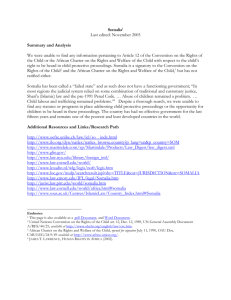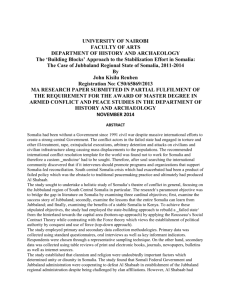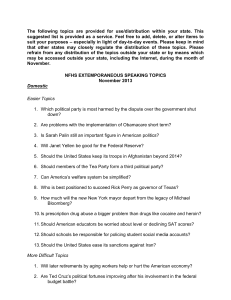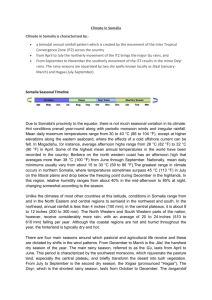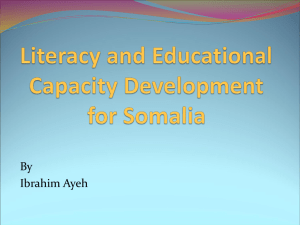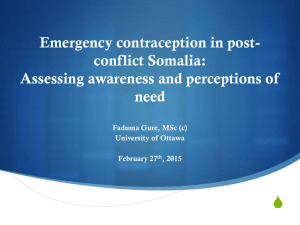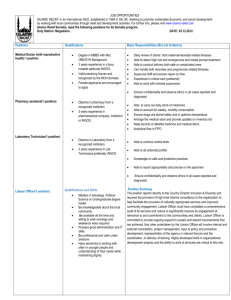Yemen: an Ideal Safe Haven for al Qaeda The Security and
advertisement
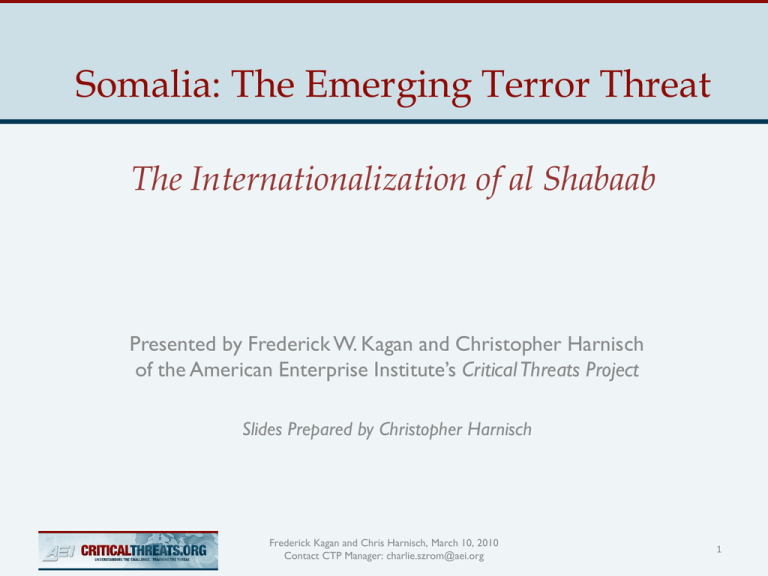
Somalia: The Emerging Terror Threat The Internationalization of al Shabaab Presented by Frederick W. Kagan and Christopher Harnisch of the American Enterprise Institute’s Critical Threats Project Slides Prepared by Christopher Harnisch Frederick Kagan and Chris Harnisch, March 10, 2010 Contact CTP Manager: charlie.szrom@aei.org 1 Map of the Horn of Africa Frederick Kagan and Chris Harnisch, March 10, 2010 Contact CTP Manager: charlie.szrom@aei.org 2 3 4 Somalia Basics: Geography • Slightly smaller than Texas, Somalia is situated strategically in the Horn of Africa near the important Gulf of Aden and Bab al Mandeb shipping routes (connecting the Indian Ocean with the Mediterranean Sea) • Key Neighbor to the West: Ethiopia – Ethiopia and Somalia have historically been bitter rivals – they fought wars over the ethnically-Somali Ogaden region in 1964 and 1977-78 (hostilities and a propaganda campaign continued until 1988); Ethiopia conducted a military campaign in 1996 to oust Islamists from its borders; Ethiopia invaded in 2006 to disband the Islamist ICU and to install the legitimate UN-backed government; it reportedly committed numerous human rights violations during the campaign – Ethiopia is currently supportive of Somalia’s Transitional Federal Government (TFG), but al Shabaab still portrays Ethiopia as a nemesis • Other neighbors – Djibouti, Kenya, and Uganda have all supported the TFG – Eritrea actively undermines the TFG by supporting al Shabaab – Yemen is a place of refuge for those attempting to escape Somalia Frederick Kagan and Chris Harnisch, March 10, 2010 Contact CTP Manager: charlie.szrom@aei.org 5 Somalia Basics: People • Population is estimated to be between 8 and10 million • World Bank describes it as “one of the poorest countries in the world” • UNHCR estimates there are 1.4 million internally displaced people (IDPs) in Somalia – More than 85,000 have been displaced in 2010 alone Frederick Kagan and Chris Harnisch, March 10, 2010 Contact CTP Manager: charlie.szrom@aei.org 6 Somalia Basics: Culture • 99% of Somalis are Sunni Muslims • Sufi Islam (a moderate practice of mystical Islam) is widely practiced in Somalia • Somalis generally consider Wahhabism as a foreign doctrine not compatible with Somali culture • Suicide – including suicide bombings – was generally considered taboo in Somali culture; certain elements of the society began accepting it after al Shabaab started using suicide attacks in 2006 • Clanism has historically played an important role in internal Somali conflicts – For a foreigner to live in Somalia, he will generally need the protection of a clan • Islamism has established roots in Somalia; Salafist Islamism in Somalia dates back to the early 1970s • Despite clanism and Islamism, Somali nationalism has always been strong Frederick Kagan and Chris Harnisch, March 10, 2010 Contact CTP Manager: charlie.szrom@aei.org 7 Somalia Basics: Political Control • The officially recognized and UN-backed government of Somalia is the Transitional Federal Government (TFG), for which Sheikh Sharif Sheikh Ahmed is the president • Most of central and southern Somalia is controlled by one of three Islamist groups: al Shabaab, Hizb al Islam, and Ahlu Sunna wa al Jama’a, with al Shabaab controlling by far the most territory • Northern Somalia is divided into two polities: Somaliland and Puntland; the Islamist influence in these regions is very limited – Somaliland is a self-declared republic with a fully-operational government – Puntland is a semi-autonomous region that has attempted to set up a functioning government but has struggled with civil-strife, corruption, and ties to piracy Frederick Kagan and Chris Harnisch, March 10, 2010 Contact CTP Manager: charlie.szrom@aei.org 8 Somalia Basics: History • • • • • • Northern Somalia was a British protectorate from 1884-1960, known as British Somaliland Central and southern Somalia was an Italian colony from 1889-1941 and a United Nations Trust Territory under Italian administration from 1950-1960, known as Italian Somaliland British and Italian Somaliland merged on July 1, 1960 to form the nation of Somalia, and representatives of the two countries elected Aden Abdullah Osman to be the first president of Somalia In October 1969 General Mohamed Siad Barre executed a military coup on the legitimate government and implemented an authoritarian socialist government Siad Barre was overthrown by a warlord in January 1991, and the country has spent the past two decades without a functioning central government ; instead warlords and Islamists have ruled sections of the country The UN has attempted to establish several interim and transitional governments – the most recent of which is the current TFG established in 2004 (its mandate expires in 2011) Frederick Kagan and Chris Harnisch, March 10, 2010 Contact CTP Manager: charlie.szrom@aei.org 9 What is Somaliland? • Somaliland is a self-declared republic in northern Somalia seeking international recognition for its independence • It is an Islamic entity that administers a functioning democracy – It has a president, parliament, cabinet, security services, and an intelligence service • It was a British protectorate from 1884 until June 26,1960 • It was an independent country for five days before it joined with the Italian Somaliland to form the new nation of Somalia • After the collapse of the Siad Barre regime, northern clans declared in May 1991 a return to an independent Somaliland and set up a functioning administration • Today, Somaliland receives support, including military training and assistance, from Ethiopia, and Ethiopia has a consulate in Somaliland • Israel has reportedly indicated a willingness to recognize Somaliland as an independent state • The TFG opposes an independent Somaliland Frederick Kagan and Chris Harnisch, March 10, 2010 Contact CTP Manager: charlie.szrom@aei.org 10 The Terror Threat from Somalia: Key Players BLUE FORCES • The Transitional Federal Government (TFG) • African Union Mission in Somalia (AMISOM) • Ahlu Sunna wa al Jama’a RED FORCES • Hizb al Islam • Al Shabaab Frederick Kagan and Chris Harnisch, March 10, 2010 Contact CTP Manager: charlie.szrom@aei.org 11 The Transitional Federal Government (TFG) • The TFG formed in 2004 after two years of negotiations and is backed by the UN and the African Union • The government relies heavily on international support for survival and for the provision of basic goods to citizens • The TFG controls only a few strategic locations in Mogadishu and has a troop presence in strategic cities and towns throughout Somalia • The current president, President Sheikh Sharif Sheikh Ahmed, assumed his position in January 2009. He had been a moderate leader within the Islamic Courts Union and was brought back into power through a UN-backed peace process Frederick Kagan and Chris Harnisch, March 10, 2010 Contact CTP Manager: charlie.szrom@aei.org 12 African Union Mission in Somalia (AMISOM) • The African Union authorized the mandate for AMISOM in Jan. 2007, which calls for 8,000 troops to be deployed to Somalia for a peacekeeping mission; the first troops arrived in Mogadishu in Mar. 2007 • The mandate is for the troops to support government infrastructures, implement a security plan, train Somali forces, and assist in creating an environment for the delivery of aid • Uganda and Burundi are the only countries to have contributed troops to the mission, though other countries have pledged to do so • As of Feb. 2010, only about 5,300 AMISOM troops were deployed and were located in strategic locations around Mogadishu protecting government interests • Al Shabaab and Hizb al Islam militants have targeted AMISOM troops because they are a foreign presence on Somali soil Frederick Kagan and Chris Harnisch, March 10, 2010 Contact CTP Manager: charlie.szrom@aei.org 13 Ahlu Sunna wa al Jama’a • Ahlu Sunna wa al Jama’a is a moderate Sufi Islamist organization that originally formed in 1991 to unite the Sufi brotherhoods • The group is generally opposed to violence and favors national unity. It tends to align itself with the government, both local and national • It works closely with the central administration in the Galmudug region and is strongest in central Somalia • Ahlu Sunna wa al Jama’a took up arms after the desecration of the tombs of Sufi saints and has clashed with both Hizb al Islam and al Shabaab militants • In Feb. 2009, Ahlu Sunna wa al Jama’a entered into talks with the TFG regarding cabinet posts for Ahlu Sunna wa al Jama’a leaders • The group is on good terms with the Ethiopian government Frederick Kagan and Chris Harnisch, March 10, 2010 Contact CTP Manager: charlie.szrom@aei.org 14 Hizb al Islam • Militant Islamist group formed by several former Islamic Courts Union leaders after the June 2007 Djibouti accord • Hassan Dahir Aweis, the former military commander of the Islamic Union and a prominent leader of the Islamic Courts Union, is the current leader of Hizb al Islam • Analysts report that Hizb al Islam is more moderate in its ideology than al Shabaab; however, the group has carried out public executions and has justified the execution of suicide bombings • It maintains a strong presence in central Somalia, including the strategic town of Beledweyne and the Afgoi district outside of Mogadishu • Hizb al Islam has both partnered with and fought against al Shabaab depending on circumstances Frederick Kagan and Chris Harnisch, March 10, 2010 Contact CTP Manager: charlie.szrom@aei.org 15 Al Shabaab Basics • The group began operating as an independent entity in early 2007 (before that, it served as the military wing of the Islamic Courts Union) • It controls much of southern and central Somalia and operates shadow governments called “Islamic Provinces” • Most estimates of al Shabaab’s man power range from 2,000 to 5,000 • The group includes between 800 and 1,100 foreign fighters, including dozens from the US and Europe • The US, UK, Canada, and Australia have all designated al Shabaab as a terrorist group • Eritrea is al Shabaab’s leading state-sponsor • The group has proven adept at following through on threats • The group has threatened to attack the United States Frederick Kagan and Chris Harnisch, March 10, 2010 Contact CTP Manager: charlie.szrom@aei.org 16 Origins of al Shabaab • • • • Al Shabaab grew out of an Islamist group formed in the early 1980s called the Islamic Union (or al Itihaad al Islamiya), which sought to establish an Islamic state in the Horn of Africa and seize the Ogaden region of Ethiopia After the collapse of the Siad Barre regime, the IU controlled several cities throughout southern Somalia for varied periods of time, until the Ethiopians recognized them as a threat and used military force to expel them from towns and forced them to operate underground In the early 2000s, a small group dedicated to protecting al Qaeda in East Africa figures and striking foreign targets inside Somalia, broke off from the IU This small group, which eventually took the name al Shabaab, became the military wing of an emerging political force in Somalia known as the Islamic Courts Union (ICU) – The ICU was a union of administrations throughout southern Somalia that sought to impose various interpretations of shari’a law; individual courts were established as early as the mid-90s, but the union was formalized in 2004 • • Ethiopia invaded Somalia in Dec. 2006 to disband the ICU, and its political leadership fled The ICU’s military wing, al Shabaab, remained to fight the Ethiopians, and it began operating as an autonomous entity by early 2007 (Ethiopia withdrew forces in January 2009) Frederick Kagan and Chris Harnisch, March 10, 2010 Contact CTP Manager: charlie.szrom@aei.org 17 Tactics of al Shabaab • From 2007 through the present, al Shabaab has used various forms of violence to target its enemies (i.e. the Ethiopians, the TFG, AMISOM, tribal leaders, and occasionally Hizb al Islam). Below are the tactics used by al Shabaab: 1)Guerilla insurgency 2)Roadside IEDs 3)Vehicle-born IEDs 4)Mortar attacks 5)Political assassinations 6)Suicide bombings Frederick Kagan and Chris Harnisch, March 10, 2010 Contact CTP Manager: charlie.szrom@aei.org 18 Al Shabaab Areas of Control • Al Shabaab has set up governing administrations called “Islamic Provinces” throughout most of southern and some of central Somalia • It currently controls nearly all of Middle and Lower Jubba regions, Gedo region, Bay region, Bakool region, and parts of Lower Shabelle region. This includes control of the key port cities of Kismayo and Marka and the Kenya border town of Diif. It also controls large parts of Mogadishu • The group wields significant influence in Middle Shabelle and Hiraan regions • The group is relatively de-centralized – In some parts of the country (i.e. Mogadishu), it works closely with Hizb al Islam, and in other parts of the country (i.e. Kismayo and Diif) it has battled Hizb al Islam for territory – Al Shabaab governs with local administrations: region-by-region and city-by-city – Al Shabaab’s military units are commanded at a local level Frederick Kagan and Chris Harnisch, March 10, 2010 Contact CTP Manager: charlie.szrom@aei.org 19 Al Shabaab’s Shadow Governments • One way al Shabaab has maintained control of areas is through its Islamic administrations that provide services generally provided by the state. These administrations: 1) Collect taxes – from aid organizations, imports at ports under their control, citizens in the form of zakat , and at checkpoints in their territory 2) Censor media 3) Build and repair roads 4) Influence the education system 5) Regulate the distribution of foreign aid • By regulating foreign aid from organizations such as the UN’s World Food Program, al Shabaab is able to portray itself as the legitimate authority in a region and as the defender of the people against a US plot to undermine Somali farmers Frederick Kagan and Chris Harnisch, March 10, 2010 Contact CTP Manager: charlie.szrom@aei.org 20 Al Shabaab’s Enforcement of Shari’a Law • Al Shabaab uses violence to enforce a draconian interpretation of shari’a, thereby instilling fear into the people in order to maintain stability and define itself as an area’s sole authority • The group has banned playing and watching soccer, watching movies, dancing at weddings, listening to music, proselytizing anything but Islam, branding animals, and the wearing of bras by women • In some districts, men are forced to wear beards and women are forced to veil • The group has publically stoned to death “adulterers” (including a 13-year-old rape victim), executed “spies” and converts to Christianity, and amputated the hands and feet of thieves Frederick Kagan and Chris Harnisch, March 10, 2010 Contact CTP Manager: charlie.szrom@aei.org 21 Al Shabaab’s Global Ideology • Al Shabaab views itself as part of the global jihad led by al Qaeda • Al Shabaab seeks to establish an Islamic state in Somalia to be part of a global Islamic Caliphate • Al Shabaab commander Abu Mansour al Amriki: “Al Shabaab had a global goal including the establishment of the Islamic Caliphate” • Al Shabaab leaders have referred to bin Laden as their “emir” and Taliban leader Mullah Omar as the “Emir al Mu’mineen” or Commander of the Faithful • In Sept. 2009, al Shabaab released a video entitled “At Your Service Osama” pledging allegiance to bin Laden • In early 2010, al Shabaab released a statement that the “jihad in the Horn of Africa must be combined with the international jihad led by the al Qaeda network” Frederick Kagan and Chris Harnisch, March 10, 2010 Contact CTP Manager: charlie.szrom@aei.org 22 Al Shabaab’s Links with al Qaeda: Training and Fighting Abroad • Many al Shabaab leaders and mid-level operatives have trained or fought abroad with al Qaeda or the Taliban • The group’s first leader, Aadan Haashi ‘Ayro (killed in 2008), and his successor, Abu Zubair, trained with al Qaeda in Afghanistan prior to 9/11 • Al Shabaab senior official and spokesman Robow Ali fought against the Americans in Afghanistan from 2001 to 2002 • Reports suggest that dozens of veterans from the wars in Afghanistan, Pakistan, and Iraq have gone to Somalia to fight with al Shabaab • Leaders and militants who have fought or trained with al Qaeda offer al Shabaab: – Contacts in al Qaeda – Technical expertise in endeavors ranging from setting up training camps to bomb-making – Battle-hardened militants Frederick Kagan and Chris Harnisch, March 10, 2010 Contact CTP Manager: charlie.szrom@aei.org 23 Al Shabaab’s Links with al Qaeda: Providing Sanctuary • Al Shabaab has provided and continues to provide sanctuary for al Qaeda in East Africa leaders and operatives, including those responsible for carrying out the 1998 US embassy attacks in Kenya and Tanzania and the 2002 Mombasa hotel attack and attempt to take down an Israel airliner • The group provided shelter to the following deceased al Qaeda in East Africa leaders partially responsible for those attacks: Abu Talha al Sudani and Saleh Ali Nabhan • The group currently provides shelter for the al Qaeda in East Africa leader, Najeh Fazul Abdullah, also a co-conspirator in the 1998 and 2002 attacks • In return for the shelter, al Shabaab has received technical expertise and recruiting assistance from the al Qaeda in East Africa leaders. In some cases, the al Qaeda leaders have also led al Shabaab units Frederick Kagan and Chris Harnisch, March 10, 2010 Contact CTP Manager: charlie.szrom@aei.org 24 Al Shabaab’s Links with al Qaeda: Common Messaging • Dating back to 2008, al Shabaab has released numerous statements pledging loyalty to al Qaeda’s leaders and placing its efforts in the context of al Qaeda’s global jihad • Al Qaeda’s leaders, including bin Laden, Zawahiri, and al Libi, have responded by releasing statements comparing the fight in Somalia with that of Iraq and Afghanistan and calling on Muslims everywhere to support the mujahideen of Somalia: – Zawahiri, Jan. 2007: “America and its slaves will be defeated…in Somalia as Allah defeated it in Afghanistan and Iraq.” – Al Libi, June 2008: “Accept nothing short of an independent Islamic state [in Somalia].” – Bin Laden, March 2009: “The war taking place [in Somalia]…is a war between Islam and the international Crusade.” Frederick Kagan and Chris Harnisch, March 10, 2010 Contact CTP Manager: charlie.szrom@aei.org 25 The Operational Link Between al Shabaab and al Qaeda • On Dec. 10, 2009, a US drone strike killed a senior al Qaeda leader in North Waziristan, Pakistan named Saleh al Somali, who was reportedly responsible for transferring fighters from Pakistan to Somalia and Yemen • In the aftermath of al Qaeda in the Arabian Peninsula’s Christmas Day attack, al Shabaab offered to send militants to Yemen • In Jan. 2010, the Somali Defense Minister accused Yemeni “rebels” of sending shiploads of arms to al Shabaab through the al Shabaab-controlled port of Kismayo • In Feb. 2010, the deputy leader of AQAP thanked al Shabaab for its willingness to send fighters to Yemen, but urged it to stay “in its battleground.” • At least two of the al Qaeda in Yemen terrorists who escaped from a Yemeni prison in February 2006 – Ibrahim al Muqri and Mansur al Bayhani – escaped to Somalia Frederick Kagan and Chris Harnisch, March 10, 2010 Contact CTP Manager: charlie.szrom@aei.org 26 Al Shabaab’s International Recruiting Targeted Recruiting through the Internet: • • • • Well-produced recruiting videos often use a combination of Arabic and English and have Arabic and English sub-titles The videos have featured English speakers, including the American-born Abu Mansour al Amriki, appealing directly to Westerners and putting al Shabaab’s efforts in the international context Some videos include English hip-hop, as opposed to Arabic Qur’anic chants The videos have clips of militant training camps reminiscent of those in Afghanistan at around the time of 9/11 Grassroots Recruiting Abroad Targeting the Diaspora: • • • Al Shabaab sympathizers at mosques and youth groups indoctrinate Somali-Americans about the duty to fight infidels Surrogate recruiters convince young recruits to join al Shabaab Al Shabaab sympathizers threaten the families of the recruits about speaking publically regarding the whereabouts of their sons Frederick Kagan and Chris Harnisch, March 10, 2010 Contact CTP Manager: charlie.szrom@aei.org 27 The Impact of al Shabaab’s International Recruiting Efforts • The groups has between 800 and 1,100 foreigners in its ranks, including Arabs, Africans, Pakistanis, Bengalis, Europeans, and Americans • Up to 100 young ethnically Somali Brits have joined al Shabaab – Many have studied at prestigious universities, such as the London School of Economics and King’s College – Some join al Shabaab to serve as doctors and engineers for the group • Over 20 Americans – nearly all of whom were ethnically Somali – have joined al Shabaab – Most hail from Minnesota – An American al Shabaab operative became the first American suicide bomber in October 2008 – At least 6 Americans are believed to have died fighting for al Shabaab Frederick Kagan and Chris Harnisch, March 10, 2010 Contact CTP Manager: charlie.szrom@aei.org 28 Al Shabaab’s Threats to the United States • Al Shabaab’s first threat to US interests came in Feb. 2008: “Al Shabaab will give them [America] a taste…of hardship in all regions where they are present in the east and west of Somalia.” • March 2008: “We assure our Muslim brothers…that we are preparing for America what will make them forget the blessed attacks in Nairobi and Dar es Salaam.” • May 2008 (from al Shabaab’s leader): “So wait, oh cursed America, for the events of the coming September [i.e. the next major attacks]. For it is not a strike, but strikes!” • Intelligence agencies have referred to vague intelligence about an al Shabaab plot focusing on the 2009 Inauguration Day ceremonies • American and South African intelligence services have also mentioned al Shabaab designs on American targets at the 2010 World Cup Frederick Kagan and Chris Harnisch, March 10, 2010 Contact CTP Manager: charlie.szrom@aei.org 29 The Financing of al Shabaab • A bulk of al Shabaab’s funds appear to come from money transfers from the Somali diaspora • The group taxes aid agencies, citizens, and imports • The UN has accused Eritrea of funding and arming the group • Some unconfirmed reports suggest that al Shabaab has charged pirates a “shelter fee” to operate out of territory that al Shabaab controls Frederick Kagan and Chris Harnisch, March 10, 2010 Contact CTP Manager: charlie.szrom@aei.org 30 The Danger of al Shabaab • Currently al Shabaab has the geographic space to operate training camps and prepare for attacks against the West • The group has demonstrated the ability to conduct sophisticated terror attacks, including double-car bombings on difficult-topenetrate targets • The group has threatened to attack the US and actively seeks the recognition of al Qaeda’s leadership, and it has demonstrated on multiple occasions the ability to carryout threats • The group has established a brigade for the sole purpose of liberating Islamic holy places abroad – al Quds Brigade • The group has militants with American and European passports that will facilitate international travel Frederick Kagan and Chris Harnisch, March 10, 2010 Contact CTP Manager: charlie.szrom@aei.org 31 Current US Policy to Combat al Shabaab • The US helps train TFG and AMISOM forces • The US provides arms to TFG and AMISOM forces – Over a six-week span in May and June 2009, the US sent about 40 tons of weapons and ammunition to the TFG • The US has launched targeted strikes on al Qaeda in East Africa leaders that support al Shabaab, such as killing Saleh Ali Nabhan with Special Forces in September 2009 • The US withholds humanitarian aid to parts of Somalia controlled by al Shabaab Frederick Kagan and Chris Harnisch, March 10, 2010 Contact CTP Manager: charlie.szrom@aei.org 32 Policy Considerations: What Have the AU and AMISOM Countries Suggested? • The AMISOM Force Commander has said that at least 20,000 troops are needed to stabilize Somalia (the current AMISOM mandate calls for 8,000 troops) • Uganda – the top contributor to the AMISOM force – has requested that the mandate be expanded to allow troops to go on the offensive against enemies • The Peace and Security Council of the AU has asked the UN to impose a no-fly zone over all of Somalia and to block ports through which insurgent groups receive arms (the measure targets Eritrea, which has been accused of arming al Shabaab by flying arms into southern Somalia and shipping them through the port at Kismayo) Frederick Kagan and Chris Harnisch, March 10, 2010 Contact CTP Manager: charlie.szrom@aei.org 33 Policy Considerations: Should the US Target Eritrea? • The UN has found decisive evidence that Eritrea helps arm and train al Shabaab • In Dec. 2009 the UN Security Council voted to impose an arms embargo on Eritrea and sanctions on specific Eritrean leaders • The US is yet to list Eritrea as a “state sponsor of terrorism” or impose sanctions on it • An alternative to sanctions could be to support Eritrea’s moderate opposition groups Frederick Kagan and Chris Harnisch, March 10, 2010 Contact CTP Manager: charlie.szrom@aei.org 34 Other Policy Considerations • Incentivizing more African nations to contribute troops to AMISOM • Pressuring the AU to expand the AMISOM mandate • Calling for a UN peace-enforcing mission to Somalia • Increasing targeted drone strikes on al Shabaab leaders Frederick Kagan and Chris Harnisch, March 10, 2010 Contact CTP Manager: charlie.szrom@aei.org 35
